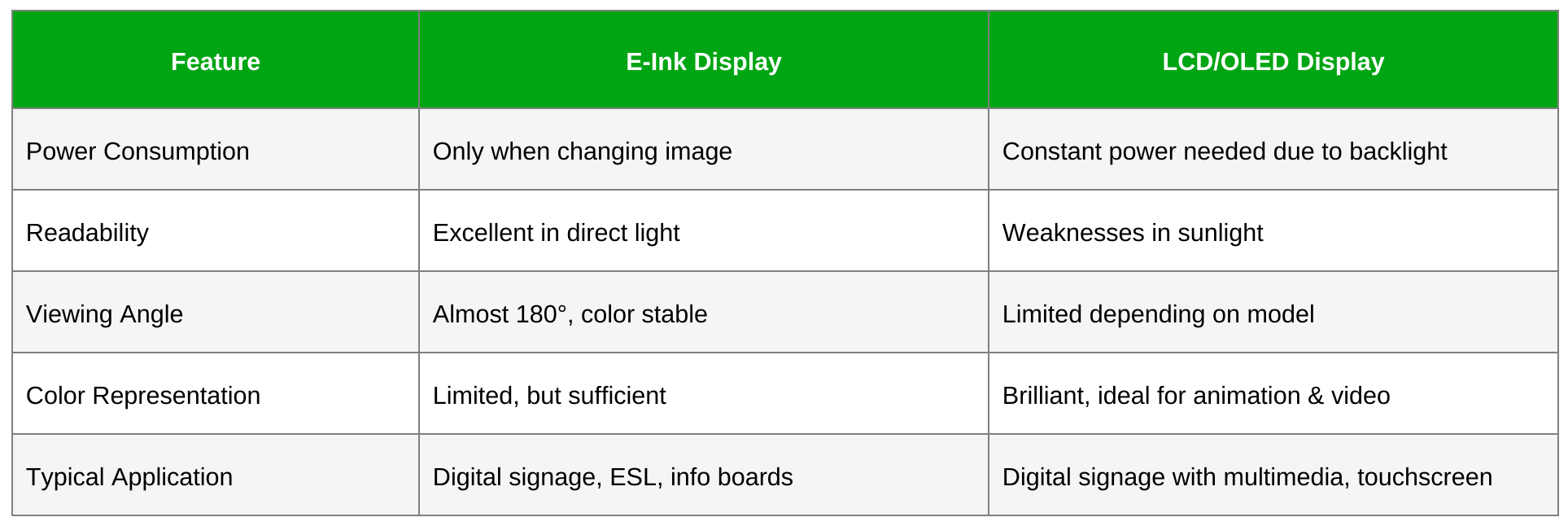
What is an e-ink display?
Functionality, Benefits, Applications & Future of Electronic Ink
E-Ink displays, also known as electronic paper, are digital signage screens with a paper-like appearance. Their ability to show content without a constant power supply makes them the ideal technology for sustainable digital signage. Especially in brick-and-mortar retail, E-Ink displays open up new potential for price communication, room management, and smart information points – efficiently, durably, and with minimal energy consumption.
1. How Does an E-Ink Display Work?
The principle is based on electrophoresis: Tiny microcapsules contain black and white pigment particles that move to the top or bottom when electrically charged – depending on whether a black or white pixel is to be displayed. This results in a razor-sharp, high-contrast image.
The key feature: once shown, the image remains visible without any further power. Power is only needed during content updates. This makes E-Ink displays particularly well-suited for digital signage where content needs to remain visible over longer periods – such as opening hours, room bookings, or pricing.
2. Technologies & Variants
E-Ink displays are available in various formats – depending on the intended use and color requirements:
- Monochrome displays (e.g., E Ink Carta) are ideal for clear, black-and-white content such as digital price tags or door signage.
- Kaleido 3 uses color filters to display up to 4,096 shades – ideal for structured, color-coded information.
- Spectra 6 was developed specifically for retail signage. With six pigments, it ensures brilliant colors and strong contrast.
- ACeP (Advanced Color ePaper) supports full RGB rendering – suitable for digital branding and promotional signage.
- Mobius relies on flexible plastic substrates and allows for curved, lightweight, or oversized signage displays.

3. Advantages & Disadvantages at a Glance
Advantages of E-Ink Displays in Digital Signage
- Extremely energy-efficient – power only required for updates
- Excellent readability in direct sunlight – no glare
- Paper-like, reflective display – easy on the eyes
- Durable and robust – ideal for high-traffic locations
- Seamless integration into existing digital signage systems
- Autonomous operation via solar or battery power
- Low maintenance, no printing costs – ideal for sustainable digital signage
Disadvantages of E-Ink Displays in Digital Signage
- Slow refresh rate – not suitable for moving images
- Limited color range in simpler models
- Requires external lighting
- Higher upfront costs – offset by savings in energy and maintenance
4. Application Areas in Digital Signage
4.1 ESL – Electronic Shelf Labels
E-Ink price tags can be linked directly to inventory or POS systems. That means no manual replacement, fewer pricing errors, and no more paper labels. Central control of this digital signage solution saves time and ensures consistent pricing – especially across multiple stores.
4.2 IoT-Displays & Smart Labels
E-Ink displays are increasingly used in IoT and smart retail: for example, as temperature indicators in refrigeration units or as QR-coded labels. They provide product-level information where it matters most – right at the shelf.
4.3 Information & Room Displays
In offices, hotels, or public buildings, E-Ink is perfect for door signs, room bookings, or info terminals. Even in case of a power outage, the content remains visible – a major advantage in safety-sensitive environments.
4.4 Large-Format Signage
E-Ink displays can also be used in large-format applications – as storefront signage, window posters, or wayfinding systems. The benefit: even in high-frequency use, power costs remain minimal, thanks to passive display logic.
4.5 Sustainable Retail Signage
In the context of green retail, E-Ink displays are a gamechanger. No printing, no paper waste, no standby power usage. They reduce operating costs and support ecological goals in retail digital signage environments.

5. Comparison: E-Ink vs. LCD/OLED

6. Future and Trends
E-Ink technology continues to evolve – creating exciting new opportunities in digital signage:
- Improved color rendering: Technologies like Spectra 6 make E-Ink displays significantly more colorful and high-contrast.
- Flexible formats: Mobius displays enable curved or mobile signage installations – even in large formats.
- Energy autonomy: Solar-powered and battery-based E-Ink systems enable long-term operation without cabling.
- Smart integrations: Paired with sensors, QR codes, or AI-driven control, E-Ink is becoming the backbone of interactive and adaptive retail signage concepts.
7. FAQ: Frequently Asked Questions about E-Ink in Digital Signage
What is an E-Ink display used for in digital signage?
An E-Ink display is a digital screen that presents content without backlighting – visible like paper. It’s ideal for retail signage and information systems where content should stay visible for long periods without frequent changes.
What are the advantages over traditional digital signage monitors?
E-Ink displays don’t require continuous power and remain readable even in bright daylight. They are ideal for sustainable signage systems in retail and public spaces.
Can E-Ink be monetized through retail media strategies?
To some extent – while not suitable for video ads, E-Ink displays can still host branded messages, promotional QR codes, or digital coupons. That makes them a smart addition to retail media networks with low energy requirements.
How fast do E-Ink displays pay off in digital signage use?
Thanks to their low power consumption, long lifespan, and elimination of print logistics, E-Ink signage often pays for itself quickly – especially in multi-location retail setups or where updates are frequent.
8. Conclusion
E-Ink displays are much more than a niche solution. In digital signage, they offer unique advantages: ultra-low energy use, excellent readability, long operating life, and versatile applications. Especially in retail and public information systems, they support the move toward smarter, more sustainable, and low-maintenance signage infrastructures. Combined with modern CMS platforms and improved color technologies, E-Ink is shaping up to be the future-ready platform for digital signage.
